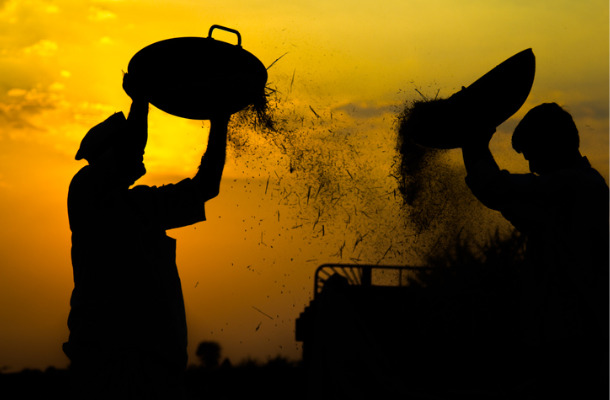
Issue 2 | Article 12
Abstract
Throughout the Industrial Era (1800-2000), a major concern of economists was the conflict between the effects of continuing increases in population and income on the demand for food and the finite supply of arable land on the supply of food. Courses in Resource Economics highlighted the Malthusian model that preached abstinence and frugality but predicted famines and early deaths. However, since the 1960s the growth rate of population has declined, per capita consumption of food has reached saturation point for about 40% of the global population, and new technologies have led to excess supply and falling real prices in farm product markets, increasing poverty among farmers, and withdrawal of land from the farming sector. This article discusses the outlook for the farm products market in the remainder of the 21st century. It also shows how recent projections have been incorporated into an undergraduate course in Economics at a higher education provider in Sydney.
Introduction
Farming is a relatively new activity for humans. The main drivers of economic production and growth throughout most of human history (it is about 3 million years since Homo habilis emerged in the Rift Valley of Africa) have been foraging and scavenging (66% of the time) and hunting (33%). It was not until the 100,000-year ice age ended about 15,000 years ago that farming emerged, slowly at first along the banks of the Euphrates and Tigris rivers in the Middle East, and then rapidly and often independently in virtually all parts of the globe apart from Australia. By the start of the Common Era (CE), more than half of the world’s population was engaged in farming (Hooke, 2019).
Farming disrupted the economic and social lives of humans. People ceased to be members of small nomadic tribes, instead forming villages that grew into towns (the first town is believed to be Jericho, about 11,000 years ago), then cities (Uruk, around 7,000 years ago) and modern economies (Sumer, in what is now southern Iraq) about 6,000 years ago. During the Farming Era (10,000 BCE – CE 1800) population rose from 4 million to 900 million and per capita income tripled to I$250 (I$ is an international dollar – what a US dollar would buy in New York in July, in this article of the year 2020). Total GWP in the 12 millennia of the Farming Era was about 60 times larger than that produced during the 3 million years of the preceding foraging, scavenging, and hunting eras.
Economics students require a strong foundation in economic principles and techniques that they can apply to the wide range of problems facing the world in the 21st century. Historical knowledge of global farm product markets provides context for an important area of resource economics and a basis for making projections of future performance in these markets. To take these economic principles, techniques, and knowledge and then critically analyse the logic, assumptions, evidence, and context presented are the corner stone of higher education built into course outcomes and graduate attributes. This is particularly the case in relation to food production as the basis of the first two goals (no poverty and zero hunger) or the United Nations Sustainable Development Goals (UN Department of Economic and Social Affairs, 2021).
Performance of the farm sector during the 19th and 20th centuries
In 1800, farm production (valued at the farmgate) accounted for around 80% of gross world product (GWP). While being replaced by industry as the main engine of economic growth during the Industrial Era (CE 1800-2000), farm production (gross agricultural product - GAP) increased 26-fold, to I$5.6 trillion (Table 1). This reflected a three-fold rise in land under farming, to 5,100 million hectares (MHa), and a 10-fold increase in land productivity, to almost I$1,100 per hectare. Nevertheless, much stronger growth of production in the manufacturing and services sectors reduced the farm sector’s share in GWP to only 7.5% in 2000. On the consumption side, global population rose six-fold during the Era, to 6.1 billion, and per capita consumption of farm products increased four-fold to I$911
Table 1. Total production (GWP) and agricultural production, 1800-2000
|
|
1800 |
1850 |
1900 |
1950 |
2000 |
AAGR (%) |
|
Production |
|
|
|
|
|
|
|
GWP (I$ b) |
268 |
920 |
3,163 |
10,873 |
74,061 |
2.9 |
|
GAP (I$ b) |
214 |
375 |
822 |
1,786 |
5,574 |
1.6 |
|
Land (MHa) |
1,420 |
1,872 |
2,624 |
4,037 |
5,100 |
0.6 |
|
Productivity (I$/Ha) |
151 |
200 |
313 |
443 |
1,093 |
1.0 |
|
GAP/GWP (%) |
80.0 |
40.8 |
26.0 |
16.4 |
7.5 |
-1.2 |
|
Consumption |
|
|
|
|
|
|
|
Population (m) |
990 |
1,260 |
1,650 |
2,540 |
6,120 |
0.9 |
|
PC Consumption (I$) |
216 |
298 |
498 |
703 |
911 |
0.7 |
Source. FAO publications, World Factbook, Hooke (2021).
Projections for the farm sector during the 21st century
Demand for farm products
We now consider how the demand for farm (food) products might change during the first and second halves of the 21st century. While changes in consumption are not the same as changes in demand (the latter assume no change in price), the price elasticity of demand for farm products is close to zero for a large and increasing proportion of the world’s population. (If people’s desire for a product is satiated, reductions in price will not cause them to consume more.) With per capita real incomes in the developing countries expected to continue rising strongly, the growth rates of demand for, and consumption of, farm products are likely to merge as we progress through the 21st century.
We start with the identity that the demand for farm products (FD) is equal to the product of population (P) and average per capita demand for farm products (C). C is the sum of the per capita consumption of farm products among high-income consumers (CH) multiplied by the share of the high-income consumers in total population (PH / P) and the per capita consumption of farm products among lower-income consumers (CL) multiplied by the share of the lower-income consumers in total population (PL / P). Formally:
FD = P * C (1)
C = (CH * PH / P) + (CL * PL / P) (2)
For population, we adopt the ‘median variant’ projections made by the UN Population Division (UNPD). These assume that fertility rates across countries will tend to converge around the long-run, stable-population rate of 2.1 and that the mortality rate will continue to decline. UNDP projects that the AAGR of population, which peaked at 2.2% in the 1960s, will fall to 0.9% in 2001-50 and 0.2% in 2051-2100.
For consumers with per capita income above about I$20,000, the income elasticity of demand for farm products is close to zero. Consumers in this category comprise most of the population in the OECD countries and the middle-income and upper-income classes in the developing countries. It is estimated to have included about 40% of the global population in 2000. Publications by the United Nations’ Food and Agriculture Organization (FAO) suggest that the per capita consumption of farm products of those in this category in 2000 was about I$1,050, implying that in the lower-income population it was I$820 (FAO, 2021). The 25% gap in per capita consumption between the high-income and the lower-income consumers is greater than the 10% difference in the calorie consumption of residents of high-income and lower-income countries (3,300 calories per day in the high-income countries – CPD – compared with 3,000 CPD in the lower-income countries) because of the higher share of more-expensive meat-sourced calories in the diets of those in the high-income countries. Based on projections of per capita income by Hooke & Alati (2021), it is assumed the per capita consumption of farm products by lower-income consumers will increase to 95% of the level of high-income consumers in 2050 and to 100% by 2100.
Table 2. Demand for Farm Products, 2021-2100
|
|
Values |
AAGR (%) |
|||
|
|
2000 |
2050 |
2100 |
2001-50 |
2051-2100 |
|
Population (m) |
6,120 |
9,740 |
10,880 |
0.9 |
0.2 |
|
PCC Ag (I$) |
911 |
1,019 |
1,050 |
0.2 |
0.1 |
|
HI consumers |
1,050 |
1,050 |
1,050 |
0.0 |
0.0 |
|
LI consumers |
818 |
998 |
1,050 |
0.4 |
0.1 |
|
GAP (I$ b) |
5,574 |
9,920 |
11,424 |
1.2 |
0.3 |
|
GWP (I$ b) |
74,061 |
514,624 |
1,730,546 |
4.0 |
2.5 |
|
GAP/GWP (%) |
7.5 |
1.9 |
0.7 |
|
|
Source. FAO publications, World Factbook, and projections by the authors.
Table 2 shows the forecasts for global food demand in 2050 and 2100. The AAGR of food demand, which was 1.6% during the Industrial Era, is projected to decline to 1.2% in 2001-50 and 0.3% in 2051-2000. The projection for 2001-50 is close to FAO’s prediction of 1.1%. Accepting the forecasts for GWP in the 21st century by Hooke & Alati (2021), the projections for food demand/consumption imply that the share of the farm sector in GWP will fall to about 2% in 2050 and less than 1% in 2100. Farming will become a boutique activity
Supply of farm products
In contrast with the demand for farm products, the price elasticity of supply of farm products is quite high. Hence, changes in the real price of farm products will cause changes in the growth of supply to diverge from changes in the growth of production. Given the low price-elasticity of demand for farm products, any imbalances between changes in demand and supply will be corrected almost entirely by adjustments on the supply side.
Again, by definition, the quantity supplied of farm products at any given real price is the (mathematical) product of land under farming (L) and average land productivity (V). The growth of farm production (fs) is thus (approximately) equal to the growth of land under farming (l) plus the growth of land productivity (v). (On the de minimis principle, we neglect the third component, lv).
Fs = L * V (3)
fs = l + v (4)
In the latter half of the 20th century, the AAGR of land productivity was 2.3%. Diamandis and Kotler (2012) have shown that land productivity is more than twice as high in the United States than in the rest of the world, mainly because US farmers use more and better inputs (machinery, irrigation, fertilisers, and pesticides) and employ better farm practices. However, the global phenomenon of converging resource and management practices is not restricted to the manufacturing and services sectors. It is also occurring in farming. Continuation of convergence across countries would double land productivity; its continuation within countries would lead to a more-than doubling. By itself, convergence would lead to an AAGR for land productivity of about 1.5% during the first half of the 21st century.
Further, despite falling real prices and a generally unfavourable investment climate for farming, new and maturing technologies are promising substantial increases in land productivity among the productivity leaders. These include incremental technologies such as genetically modified plants (resulting in, for example, more, bigger, and tastier oranges per tree) and animals (e.g., more and better milk per cow) and precision farming, which provides customised treatment to individual plants, allowing every plant to reach its optimum size, quality, and appearance potential. They also include radical technologies that reduce substantially the need for land, such as vertical farming, or even eliminate the need for land completely, such as 3D printing of meat and milk.
The area of the Earth’s surface is approximately 51,000 MHa, of which 36,100 MHa (71%) is covered by oceans (Table 3). Almost a third of the land is uninhabitable. Habitable land is divided evenly between forests/shrubs (5,000 MHa) and human activities (5,250 MHa). The latter is almost entirely farming – land for urban purposes (such as houses, offices, factories, schools, roads, and sporting fields) account for only 3% of habitable land, 1% of global land, and 0.3% of the area of the Earth. Approximately 80% of farmland is used for pastoral activities (e.g., tending of cattle, pigs, sheep, goats, and chickens) and the remainder is used for cultivating crops (mainly wheat, soy beans, rice, fruits, and vegetables).
Table 3. Global land use, 2000
|
|
MHa |
% of Earth |
% of Land |
|
Earth |
51,000 |
100.0 |
|
|
Oceans |
36,100 |
70.8 |
|
|
Land |
14,900 |
29.2 |
100.0 |
|
Uninhabitable |
4,650 |
9.1 |
31.2 |
|
Deserts |
2,900 |
5.7 |
19.5 |
|
Glaciers |
1,600 |
3.1 |
10.7 |
|
Freshwater |
150 |
0.3 |
1.0 |
|
Habitable |
10,250 |
20.1 |
68.8 |
|
Forests & shrubs |
5,000 |
9.8 |
33.6 |
|
Human activities |
5,250 |
10.3 |
35.2 |
|
Urban |
150 |
0.3 |
1.0 |
|
Farming |
5,100 |
10.0 |
34.2 |
|
Crops |
1,100 |
2.2 |
7.4 |
|
Livestock |
4,000 |
7.8 |
26.8 |
Source. FAO publications
The combination of convergence and incremental innovations should allow land productivity to maintain its late 20th century AAGR of 2.3% in the first half of the 21st century. This would halve the area of land under farming to 2,500 MHa in 2050. The projected increase in global population of 60% and a rise in the urbanisation ratio from 50% to 70% would increase the demand for urban land. However, urban development is not land-intensive, and the increase would be only 100 MH. For lack of any alternative use, the remaining 2,500 MHa released from farming would presumably be transformed into forests/shrubs, increasing the area under the latter to about 7,500 MHa, or about its level at the beginning of the Farming Era. More radical innovations, such as vertical farming and 3D printing of food, which (if not superseded) should be mature technologies by the second half of this century, would release most of the remaining farm land, allowing the area under forests to rise well above its pre-farming era level.
Changes in Economics course
A course in Economics inherited by one of the authors included a 3-hour topic on Resource Economics. The theme of the course was that increases in population and incomes are placing excessive demands on farmland, increasing farm product prices, and aggravating global poverty. It suggested that policies should focus on (1) reducing wastage (currently, 40% of farm production does not complete the journey “from the farm to the fork”), (2) increasing expenditure on research to raise land productivity, and (3) ensuring that more land is not allocated to golf courses and other (micro) land-intensive leisure pursuits.
The unit has been modified to describe, analyse, and evaluate the land-abundance as well as the land-scarcity scenario. Students work through mathematical models to derive the effects of the two scenarios on the dependent variables of food production, land required for farming, and global poverty. They then apply critical thinking techniques to assess the logic, assumptions, and evidence used in the models. Coursework provided online by the students after the class mostly contain the following conclusions: (1) Because the price elasticity of demand for farm products is very low compared to that of supply, reduction in wastage by high-income consumers would reduce production and the incomes of farmers, but have a negligible impact on food available to low-income consumers; (2) Again because of relative price elasticities, supporting new technologies that increase supply have the perverse effect of reducing price by a much greater percentage than they increase production. Since about 90% of the world’s poor are farmers who earn most of their income from the sale of farm products but spend a vastly smaller proportion on buying farm products, measures that increase supply aggravate global poverty; (3) Doubling or tripling land area used for leisure activities would have a negligible impact on land available for farming (which, in any case, is not in short supply); and (4) Most of the land now used for farming will, for lack of any alternative use, revert to forests/shrubs during the present century.
References
Diamandis, P. and Kotler, S. (2012. Abundance: The Future is Better Than You Think. Free Press.
FAO (2021). How to feed the world in 2050. Retrieved from https://www.fao.org/fileadmin/templates/wsfs/docs/expert.
Hooke, A. (2019). Global Economic Development: Past. Present, and Future. Lakeland House.
Hooke, A. and Alati, L. (2021). Technological Breakthroughs and Future Business Opportunities in Education, Health, and Outer Space. IGI Global.
Johns Hopkins Center for a Liveable Future (2021). History of Agriculture. Retrieved from https://www.foodsystemprimer.org/food-production/history-of-agriculture.
UN Department of Economic and Social Affairs (2021). The 17 Goals, Retrieved from https://sdgs.un.org/goals.
Biographies

Professor Angus Hooke is Senior Scholarship Fellow and Co-Director of the Centre for Scholarship and Research (CSR) at UBSS. His earlier positions include Division Chief in the IMF, Chief Economist at BAE (now ABARE), Chief Economist at the NSW Treasury, Director of Research at the National Farmers’ Federation (NFF), Professor of Economics at Johns Hopkins University, and Head of the Business School at the University of Nottingham, Ningbo, China. Angus has published 11 books and numerous refereed articles in prestigious academic journals.

Emeritus Professor Greg Whateley is the Deputy Vice Chancellor, Group Colleges Australia (GCA). Formerly, he was Chair of the Academic Board at the Australian Institute of Music and Dean of the College at Western Sydney University. He has been keenly interested in alternative modes of delivering education since 2000 when he co-invented ‘The Virtual Conservatorium’ and has since found himself involved, some twenty years later, in the development of the virtual school. Greg is a prolific writer, with about 40 articles accepted for publication in the last 18 months.

Professor Andrew West is Dean of the Universal Business School Sydney (UBSS) and Provost of the Blended Campus. Formerly, he was Director of the Centre for Entrepreneurship at UBSS. Andrew has worked in academia for 14 years, following a successful 10-year career an entrepreneur and business owner/manager. His research output includes 12 peer-reviewed journal articles and numerous conference papers. Andrew’s main research areas are marketing and higher education.




